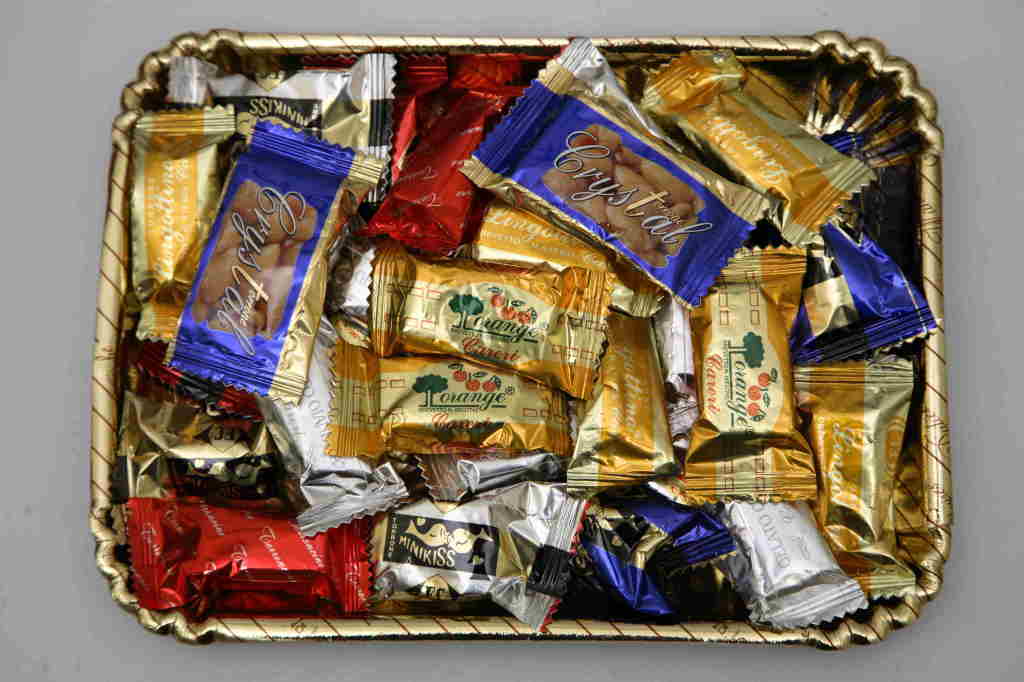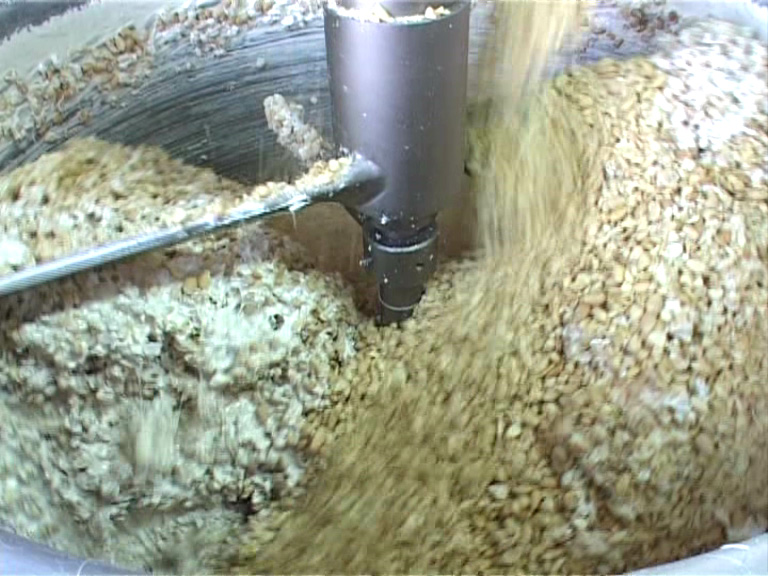 At Bagnara Calabra, as well as at Tauranga, in the heart of the plain of Gioia Tauro, at Delianova, and Gioiosa Jonica (which remains ‘unbeaten’ in the Guinness Book of World Records for its longest Nougat in the world), the story of nougat loses itself in a remote past. It was prepared only with toasted hazelnuts in sugar icing. The ‘Nougat of Bagnara Calabra’ is an incomparable sweet, handed down from generations to generations, typical, fresh, handmade with unique raw materials, following ancient techniques. It is obtained by cooking and processing sugar and toasted almonds, with the addition of honey, egg whites, cocoa, essential oils, and powdered spices, depending on the specific variants, 'Martiniana' or 'Torrefatto glassato’.
At Bagnara Calabra, as well as at Tauranga, in the heart of the plain of Gioia Tauro, at Delianova, and Gioiosa Jonica (which remains ‘unbeaten’ in the Guinness Book of World Records for its longest Nougat in the world), the story of nougat loses itself in a remote past. It was prepared only with toasted hazelnuts in sugar icing. The ‘Nougat of Bagnara Calabra’ is an incomparable sweet, handed down from generations to generations, typical, fresh, handmade with unique raw materials, following ancient techniques. It is obtained by cooking and processing sugar and toasted almonds, with the addition of honey, egg whites, cocoa, essential oils, and powdered spices, depending on the specific variants, 'Martiniana' or 'Torrefatto glassato’.
The traditional Nougat of Bagnara - which obtained the IGP quality acknowledgement - has its origins in the eighteenth century, through the creation of local groceries which linked the traditional production of almonds and honey, typical of this Tyrrhenian town of Calabria, with sugar and drugs which came from outside. In the specifications it is possible to read that the ingredients at the roots of the ‘Nougat of Bagnara Calabra’ must be mixed in precise quantities, and with particular methods of cooking, processing, and packaging which characterize the brand that safeguards this product. In order to guarantee that the specification are respected and the IGP trademark can be applied to this Nougat, the sweet must be produced exclusively within the administrative boundaries of the municipality of Bagnara, a town on the ‘Costa Viola’, where the ‘Torronai’, the artisan producers of Nougat (the Italian word ‘torrone’ means ‘nougat’), have kept alive both traditions and processing method. The processing of this product requires a good deal of manual ability and expertise, especially in measuring the quantity of ingredients, controlling the direct heat cooking process as well as modelling operations, which require skilled and experienced workers’ action.
An ancient confectionery art
After the World War II, the flowering of a series of small companies led to the realization of a true District of the Nougat of Bagnara Calabra.
Among the most ancient manufacturers, there is the confectioner’s shop ‘Fabbrica Torrone Careri’, founded in 1967, precisely at Bagnara. Here the story of its craft products, today known both in Italy and abroad, begins. These products are exported to Canada, USA, Australia, Norway, and Switzerland, thanks to their high quality and respect for traditions.
 Ferdinando Careri, owner of the homonymous ‘Nougat Factory’, explains: «Over the years, the connotation of our production system allowed acquiring specific techniques, as well as developing and maintaining knowledge and skills which have been handed down from generation to generation. These knowledge and skills are not found in other areas. The local specialized vocabulary, too, has remained the same over the centuries. For instance, the term ‘Manto di Monaco’ (monk’s mantle), for indicating the colour of nougat, ‘cotta’ (cooked), for indicating the hot and still formless nougat paste, the ‘torroniera’, for indicating the particular boiler used by master confectioners, ‘rottura vitrea’ for indicating the result of a particular technique which highlights the ability of controlling the production process at high temperatures.
Ferdinando Careri, owner of the homonymous ‘Nougat Factory’, explains: «Over the years, the connotation of our production system allowed acquiring specific techniques, as well as developing and maintaining knowledge and skills which have been handed down from generation to generation. These knowledge and skills are not found in other areas. The local specialized vocabulary, too, has remained the same over the centuries. For instance, the term ‘Manto di Monaco’ (monk’s mantle), for indicating the colour of nougat, ‘cotta’ (cooked), for indicating the hot and still formless nougat paste, the ‘torroniera’, for indicating the particular boiler used by master confectioners, ‘rottura vitrea’ for indicating the result of a particular technique which highlights the ability of controlling the production process at high temperatures.
The ‘Fabbrica Torrone Careri’, guardian of the ancient art of confectionery, continues to enchant the world with its sweet creations, among which there are the classic nougats, «all rigorously prepared with almonds, orange-blossom honey, sugar, egg white, with different variants from time to time»: chocolate, friable, stick-shaped, covered with pure extra dark chocolate; ‘Ostiato’, with two layers of wafer (the Italian term ‘ostia’ means ‘wafer’, too), and flavourings; Cinnamon, stick-shaped, typical of Bagnara, covered with bicoloured ‘nasprato’ sugar, that is brushed by hand, on three sides with white sugar and on one side with sugared cocoa; Roasted, characterized by intense and aromatic taste, which is also covered with ‘nasprato’ sugared cocoa (alongside with Martiniana, this nougat boasts the IGP certification); Almond Nougat (Martiniana), the most ancient of the classic nougats. Many specialties, too, are proposed: Crystal, crunchy nougat containing 70% of almond in addition to orange-blossom honey and sugar; ‘Ostiato’, with almonds, orange- blossom honey, egg whites, sugar, wafer, flavourings; ‘Gianduja’ ice cream, tasty icy soft nougat, enriched with candied fruit, ground hazelnut, and covered with pure extra dark chocolate; ‘Mini Kiss’, delicious nougat, covered with pure extra dark chocolate.
And where there is excellence, ‘ad hoc’ patents cannot be absent: this happens for the ‘Lingottino’, a Careri patent, crumbly nougat covered with pure extra dark chocolate; and for ‘Orange', delicious nougat flavoured with orange and covered with pure white chocolate.
The flavour’s rite
 A simple, elegant and colourful packaging recalls the scents, flavours, and nuances of these products. This production technique is a rite which reminds gestures, knowledge, art, and flavours of the past, for preparing nougats in traditional rectangular or round formats, both small and medium- sized. Careri explains: «Toasted almonds are combined with white egg and honey and cooked in a bain-marie for about six/seven hours, constantly stirring with a palette knife in order to guarantee even cooking. Today, this operation is carried out in special equipment with automatic spatulas, but without losing the typical uniqueness of our products. At the end of cooking, the paste is rolled with a rolling pin and left to cool; the soft nougats are cut into many small bars in different sizes, while friable nougats, in order to be cut, must have a temperature between 35 /40°C».
A simple, elegant and colourful packaging recalls the scents, flavours, and nuances of these products. This production technique is a rite which reminds gestures, knowledge, art, and flavours of the past, for preparing nougats in traditional rectangular or round formats, both small and medium- sized. Careri explains: «Toasted almonds are combined with white egg and honey and cooked in a bain-marie for about six/seven hours, constantly stirring with a palette knife in order to guarantee even cooking. Today, this operation is carried out in special equipment with automatic spatulas, but without losing the typical uniqueness of our products. At the end of cooking, the paste is rolled with a rolling pin and left to cool; the soft nougats are cut into many small bars in different sizes, while friable nougats, in order to be cut, must have a temperature between 35 /40°C».
